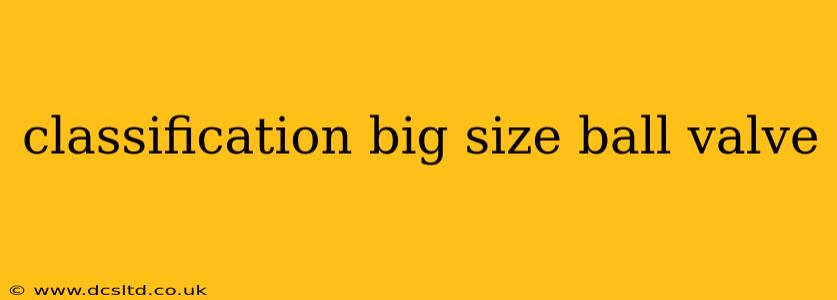Large-size ball valves, typically exceeding 2 inches in diameter, play a crucial role in various industries, including oil and gas, water treatment, and power generation. Their classification is multifaceted, considering factors beyond just size. This comprehensive guide delves into the various ways these essential valves are categorized, providing clarity and insights for engineers, technicians, and anyone working with large-scale fluid control systems.
Types of Large-Size Ball Valves Based on Body Material
The material of the valve body significantly impacts its performance, durability, and application. Common materials and their suitability are:
- Cast Iron: Cost-effective for low-pressure applications, but limited in high-temperature or corrosive environments.
- Ductile Iron: Offers improved strength and ductility compared to cast iron, suitable for moderate pressure and temperature ranges.
- Stainless Steel: Excellent corrosion resistance and high strength, ideal for demanding applications involving chemicals or high temperatures. Different grades (e.g., 304, 316) cater to specific needs.
- Forged Steel: Provides superior strength and reliability for high-pressure and critical applications.
- Special Alloys: Materials like Monel, Hastelloy, or Inconel are selected for extreme conditions involving highly corrosive fluids or high temperatures.
Types of Large-Size Ball Valves Based on End Connections
The method of connecting the valve to the piping system is another key classification factor:
- Flanged: Uses flanges bolted together to secure the valve to the pipeline. This allows for easy disassembly and maintenance. Flanged connections are common for larger valves due to their strength and ease of handling.
- Butt-Welded: The valve body is directly welded to the pipe, creating a permanent and strong connection. This method is preferred where leak-proof seals are critical, particularly in high-pressure systems.
- Threaded: Suitable for smaller sizes, threaded connections are less common in large-size ball valves due to the potential for leakage and difficulty in assembly.
- Socket-Welded: Similar to butt-welding, but involves a socket on the valve for insertion of the pipe before welding. Often used for smaller diameter connections within a larger valve assembly.
Types of Large-Size Ball Valves Based on Flow Characteristics
Ball valves offer different flow characteristics depending on design:
- Full-Bore: The internal diameter of the valve is equal to the pipe diameter, minimizing pressure drop and turbulence. This is a common choice for large-size valves where flow restriction is undesirable.
- Reduced-Bore: The internal diameter is smaller than the pipe diameter, leading to increased pressure drop. This design can be more cost-effective for certain applications but may not be suitable for high flow rates.
How Are Large-Size Ball Valves Different from Smaller Ones?
The primary difference lies in their size and the corresponding design considerations. Large valves require more robust construction, stronger materials, and often specialized handling and installation equipment. Furthermore, the implications of failure are greater with larger valves, necessitating rigorous quality control and maintenance procedures. Larger valves also usually have different actuation methods, often requiring pneumatic or electric actuators due to the increased force needed for operation.
What are the Common Applications of Large-Size Ball Valves?
Large-size ball valves find their use in a vast array of industrial settings. Some examples include:
- Oil and Gas Industry: Controlling the flow of hydrocarbons in pipelines and processing plants.
- Water Treatment: Regulating water flow in distribution networks and treatment facilities.
- Power Generation: Managing steam and water flow in power plants.
- Chemical Processing: Controlling the flow of various chemicals and fluids.
- Pulp and Paper: Regulating the flow of slurries and liquids.
What Factors Should I Consider When Choosing a Large-Size Ball Valve?
The selection process involves carefully considering the specific application requirements, including:
- Operating pressure and temperature: The valve must withstand the expected pressure and temperature conditions without compromising safety or performance.
- Fluid characteristics: The valve material must be compatible with the fluid being handled (corrosiveness, viscosity, etc.).
- Flow rate: Selecting the appropriate size and type (full-bore or reduced-bore) is critical to ensure optimal flow.
- Cycle life and durability: The chosen valve should meet the expected number of operation cycles and longevity requirements.
- Maintenance accessibility: Consider the ease of maintenance and repair.
This comprehensive guide provides a thorough overview of the classification of large-size ball valves. Remember that selecting the correct valve is critical for ensuring efficient and safe operation within any industrial application. Consult with valve specialists and refer to relevant industry standards for specific project requirements.
